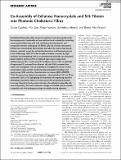Co‐Assembly of Cellulose Nanocrystals and Silk Fibroin into Photonic Cholesteric Films
Author(s)
Guidetti, Giulia; Sun, Hui; Ivanova, Alesja; Marelli, Benedetto; Frka‐Petesic, Bruno
DownloadPublished version (1.920Mb)
Publisher with Creative Commons License
Publisher with Creative Commons License
Creative Commons Attribution
Terms of use
Metadata
Show full item recordAbstract
Controlled self-assembly of bio-sourced nanocolloids is of high importance for the development of sustainable and low-cost functional materials but controlling nanocomposite fabrication with both satisfactory optical properties and composition remains challenging. Silk fibroin (SF) and cellulose nanocrystals (CNCs) have independently demonstrated their ability to produce high-quality photonic materials, in part due to their low absorbance and their transparency in the visible range. While SF is able to replicate inverse structures by high-resolution nano-templating, CNCs can spontaneously assemble into cholesteric liquid crystalline structures that are retained upon solvent evaporation, yielding photonic films. In this work, the conditions of successful co-assembly of regenerated SF, extracted from silkworm silk, with CNCs extracted from cotton, are investigated. Their co-assembly is investigated for various relative concentration ratios and pH, combining polarized optical microscopy and spectroscopy, SEM, and other characterization techniques (XRD, ATR-FTIR, TGA). The appearance of photonic properties is observed when CNC and SF are assembled at pH ≥ 4.15, highlighting the importance of suppressing attractive electrostatic interactions between the two species for an organized structure to emerge. Beyond its fundamental motivations for colloidal co-assembly with structural proteins, this work is relevant to design sustainable optical materials compatible with food packaging coatings and edible coloring pigments.
Date issued
2021-03Department
Massachusetts Institute of Technology. Department of Civil and Environmental EngineeringJournal
Advanced Sustainable Systems
Publisher
Wiley
Citation
Guidetti, G., Sun, H., Ivanova, A., Marelli, B., Frka-Petesic, B., Co-Assembly of Cellulose Nanocrystals and Silk Fibroin into Photonic Cholesteric Films. Adv. Sustainable Syst. 2021, 5, 2000272.
Version: Final published version
ISSN
2366-7486